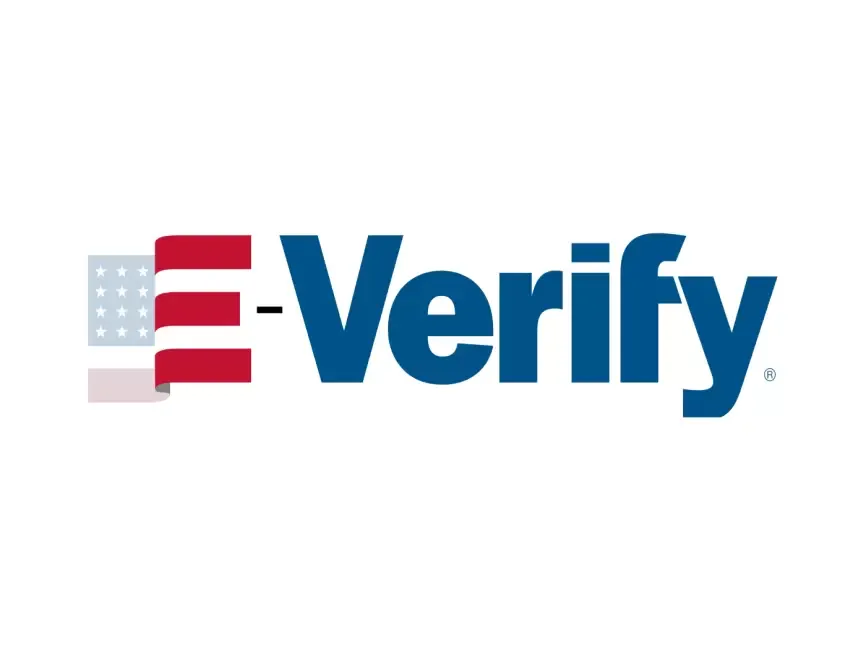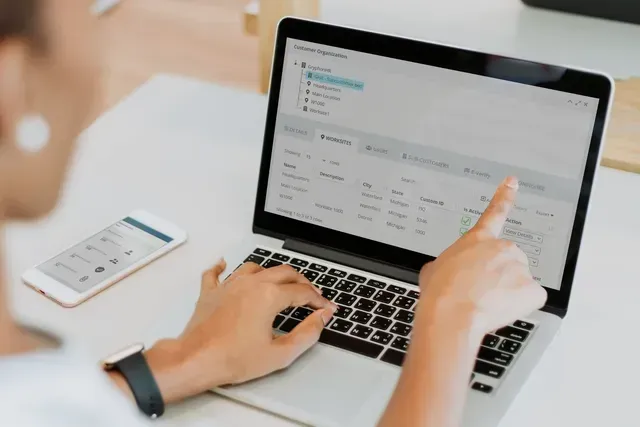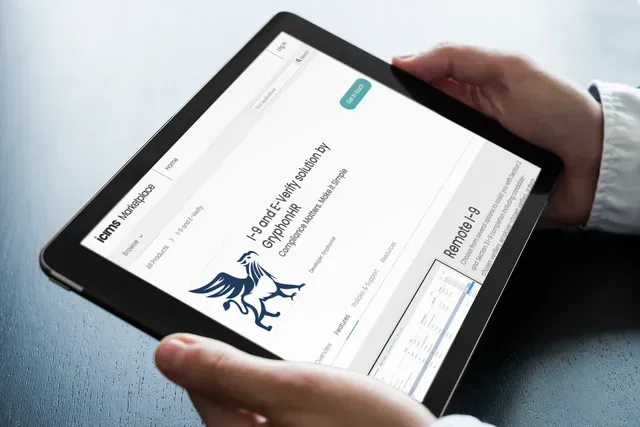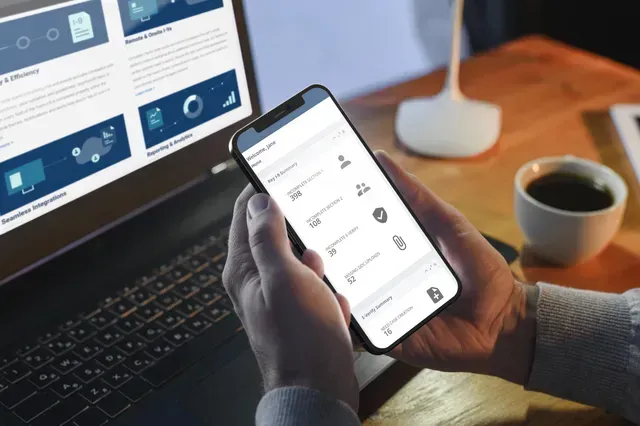GryphonHR Blog & News
Stay up to date with Form I-9 and E-Verify. Subscribe to our blog and newsletter.

On Friday June 20, 2025, USCIS sent an e-mail to E-Verify employers and posted information on its website about a new “Status Change Report” that lists revoked Employment Authorization Documents (EADs) for certain impacted employees. Employers that obtain this report and see a status change for EADs need to check-in with their employees who presented the EADs on the list and reverify their employment authorization, providing the opportunity to present other documentation as proof of continuing work authorization. The Department of Homeland Security (DHS) is presently revoking the EADs of parolees who were granted work authorization. It’s possible that while in the U.S., impacted employees may have obtained a different work authorized status and have another basis for employment. (For example, an employee who entered as a parolee under the CHNV program may have applied for asylum and have an EAD based on that application.) The E-Verify notices sent and posted on June 20 link to an EAD Revocation Guidance For E-Verify Employers | E-Verify. This guide includes a table that lists the “Date Employee’s EAD was Revoked” (currently listed as range) and the “Date Information Available in E-Verify Status Change Report” (currently June 20, 2025). The E-Verify notices indicate that the case status report will be “regularly updated as DHS revokes EADs”. Direct E-Verify user employers must run the reports in their E-Verify accounts. Employers working with an E-Verify agent must obtain the report from the E-Verify agent. Employers that do not regularly review reports and take required action (re-verification or termination, depending on evidence of continuing employment) run the risk of continuing to employ unauthorized workers.

The Form I-9 employment verification process has been a routine part of hiring in the United States, ensuring that businesses verify the work authorization of their employees. However, for organizations with remote workforces, the traditional requirement of in-person document verification has posed significant logistical and administrative challenges. To address these concerns, the Department of Homeland Security (DHS) introduced the alternative procedure for Form I-9 document verification in 2023, which allows qualifying employers to complete the verification process remotely. While this new option provides greater flexibility, it also comes with eligibility criteria and compliance requirements that organizations must fully understand before implementation. In this article, we will break down the DHS alternative procedure policy requirements, explain what employers need to do to stay compliant, and highlight how GryphonHR’s I-9 compliance solutions can help businesses navigate this evolving landscape. What is the DHS Alternative Procedure? The DHS alternative procedure, introduced on August 1, 2023, enables certain employers to verify Form I-9 documents remotely rather than conducting in-person inspections. This policy was developed following the expiration of COVID-19 temporary flexibilities, which had allowed remote document verification due to pandemic-related restrictions. Under this new procedure, eligible employers can use live video interaction to verify employee identity and work authorization documents instead of requiring physical presence. However, this option is not available to all employers—only those who meet specific DHS and E-Verify participation requirements may use it. Eligibility Requirements for Using the Alternative Procedure Employers must meet several key requirements to qualify for the DHS alternative procedure: 1. Active E-Verify Enrollment To use remote I-9 verification, employers must: Be enrolled in E-Verify at the time of verification. Be in good standing with E-Verify, meaning they have complied with program rules. Have completed an E-Verify case for every employee for whom they use the alternative procedure. 2. Consistent Application Across the Workforce Employers cannot selectively apply the alternative procedure on a case-by-case basis. Instead, they must: Use the same verification method for all employees at a specific worksite or hiring location. Apply the alternative procedure consistently for all remote hires (if choosing to use it for remote workers). Ensure no discriminatory practices in how the procedure is implemented. Employers still have the option to conduct in-person document verification if they prefer. However, once the alternative procedure is chosen for a group of employees, it must be used uniformly to maintain compliance. 3. Live Video Interaction Requirement Employers must personally review documents during a live video call—simply receiving scanned copies of documents via email is not enough. The process includes: Employees submitting copies (photos or scans) of their identity and work authorization documents. Employers scheduling a real-time video call to examine the physical documents while the employee presents them on-screen. Confirming that the documents appear genuine and belong to the employee. This step ensures that employers properly verify the documents before completing Section 2 of Form I-9. 4. Document Retention and Recordkeeping Unlike the traditional in-person verification process, the alternative procedure requires employers to: Retain copies of all documents that employees present for verification. Store these copies securely for the entire retention period required under Form I-9 rules (typically three years after the date of hire or one year after termination, whichever is later). Ensure that records are easily accessible in case of an audit or compliance review. Steps for Employers to Implement the Alternative Procedure For employers who meet the eligibility criteria, the process of using the DHS alternative procedure involves four key steps: Step 1: Employee Submits Documents The employee provides digital copies of their Form I-9 documents before the live video call. Employers must ensure that the copies are clear and legible. Step 2: Live Video Verification Employers schedule and conduct a live video meeting with the employee. The employee physically holds up their original documents for verification. The employer verifies that the documents match those submitted and appear authentic. Step 3: Form I-9 Notation and Completion The employer completes Section 2 of Form I-9, indicating that the alternative procedure was used. A checkbox is available in Section 2 to confirm remote verification. Step 4: Secure Document Storage The employer retains copies of the documents in a secure digital or physical format for recordkeeping. The documents must be accessible for DHS or ICE audits if requested. Potential Compliance Risks and Challenges While the alternative procedure offers convenience, it also introduces new compliance risks that employers must carefully manage. 1. Discrimination and Inconsistent Application Employers must avoid discrimination claims by applying the alternative procedure uniformly and ensuring it is not used selectively in a way that disadvantages any employee or group of employees. 2. Security and Data Privacy Storing employee document copies creates additional data security responsibilities. Employers should use encrypted digital storage and implement access controls to protect sensitive information. 3. Audit Readiness Since DHS may conduct audits to review compliance, employers must ensure they have complete E-Verify records for all employees verified remotely, properly stored document copies, and they have followed all steps required by the alternative procedure. How GryphonHR Simplifies I-9 Compliance for Remote Verification Managing Form I-9 verification—especially under the DHS alternative procedure—requires advanced compliance tools, secure document management, and seamless automation. GryphonHR’s I-9 compliance platform provides a comprehensive solution to help employers navigate the complexities of remote verification. Why Choose GryphonHR for Your I-9 Process? Seamless Remote I-9 Verification – GryphonHR’s platform supports live video-based verification, ensuring compliance with DHS rules. Automated E-Verify Integration – GryphonHR streamlines E-Verify case submissions, reducing manual errors and delays. Secure Digital Document Storage – Employers can securely store and manage employee documents, ensuring audit readiness. Compliance Alerts & Guidance – GryphonHR provides real-time compliance tracking, helping HR teams avoid risks and maintain consistency. Virtual I-9 remote completion – engage with GryphonHR as a virtual agent and have your employees meet with us remotely to complete the I-9 using the DHS alternative procedure method. The DHS alternative procedure represents a major step forward in modernizing employment verification, but it also demands strict adherence to federal compliance rules. GryphonHR helps employers navigate these changes by automating remote verification, enhancing security, and ensuring full I-9 compliance. Ready to Upgrade Your I-9 Process? Contact GryphonHR today to learn how our I-9 compliance solutions can help you streamline remote verification, reduce compliance risks, and improve hiring efficiency.

In today’s complex regulatory environment, employers must prioritize compliance with various labor and immigration laws, especially when it comes to verifying the identity and work eligibility of employees. The Form I-9, required by U.S. Citizenship and Immigration Services (USCIS), is a crucial document for ensuring that employers are hiring individuals who are authorized to work in the United States. Regular I-9 audits are essential to avoid costly penalties, ensure workforce compliance, and streamline the hiring process. 1. Understand the I-9 Requirements Before embarking on an I-9 audit, it’s important to have a thorough understanding of the requirements associated with the form. The Form I-9 must be completed for every employee hired after November 6, 1986, and must be retained for at least three years after the date of hire, or for one year after the employee’s employment is terminated—whichever is later. The form is divided into three sections: Section 1 : The employee’s personal information, including citizenship status. Section 2 : The employer’s verification of the employee’s documents to confirm work eligibility. Supplement B (formerly Section 3) : Used for reverification or rehires. The forms must be accurately completed, and the documentation provided by employees should be examined and verified. Incomplete or incorrect forms can lead to penalties. 2. Prepare for the Audit An I-9 audit begins with preparation. To ensure you conduct a smooth and effective audit, follow these steps: a. Review Existing Policies and Procedures Start by evaluating your current I-9 procedures. Ensure that your HR team or hiring managers are consistently following proper protocol for completing the forms. A clear, documented process for filling out I-9s and managing records is crucial. If you rely on paper forms, consider transitioning to an electronic I-9 solution, which streamlines data collection, reduces human error, and provides a centralized location for managing I-9 forms. b. Gather All I-9 Forms and Supporting Documents For the audit, you’ll need to collect all current and past employees’ I-9 forms. If you’re using a digital system, this should be a straightforward process. Otherwise, gather all the physical files, which may include additional paperwork like copies of supporting documents for each employee. Organize the documents by hire date or employee group to ensure a structured audit process. Be sure to include any I-9 forms for employees who have left your organization, as their forms must be retained for the legally required time. c. Identify a Team or Partner for the Audit Depending on the size of your organization, you may need a dedicated team to handle the I-9 audit. For smaller organizations, HR personnel or a compliance officer might suffice. For larger businesses, consider hiring an external consultant or law firm specializing in immigration compliance. Ensure that the team understands the regulations around the I-9 process and is equipped with tools, like checklists or I-9 software, to guide them through the audit. 3. Conducting the I-9 Audit Once you’ve gathered the necessary materials and formed your audit team, it’s time to dive into the audit process. The audit involves reviewing all I-9 forms and identifying discrepancies, errors, or missing information. a. Check for Completeness and Accuracy Examine each I-9 form to ensure the following: Section 1 : Has the employee filled out the section completely and signed it? Ensure that the employee’s name, date of birth, and other identifying information are accurate. For forms dated after March 2013, but before August, 2023, make sure N/A values are populated for required fields, where applicable. Section 2: Has the employer reviewed the employee’s documents, listed the correct document numbers, and signed the form on time? The employer’s signature is required within three business days of hire. For forms dated after March 2013, but before August, 2023, make sure N/A values are populated for required fields, where applicable. Supplement B (formerly Section 3) : If the employee has been rehired or the work authorization has expired, has the form been properly updated and signed? Common mistakes include missing or incorrect document numbers, incorrect document expiration dates, failure to reverify work authorization, and missing signatures. b. Verify Document Authenticity It’s essential to ensure that the documents submitted by employees for identity and work authorization are legitimate and match the details on the I-9 form. Be cautious of any discrepancies in the documents or signs that the documents may be fraudulent. Employers are not required to be experts in document verification, but they should be familiar with what constitutes acceptable documents and ensure they match the categories listed in the I-9 form. The USCIS provides a Handbook for Employers to guide document verification. c. Address Errors and Non-Compliance When you identify errors or omissions, document each instance and correct the issue. Some errors can be easily corrected by updating the form, while others might require more complex adjustments. If the error is severe, such as hiring someone who is not authorized to work, consult legal counsel immediately. If an employee is no longer with the company and the form is incomplete, it may be necessary to create a new, corrected I-9 if the record-keeping requirement is still in effect. However, if the employee has already left, and the form is beyond the retention period, the document may be discarded. 4. Reporting and Correcting Non-Compliance Once the audit is complete, compile a report detailing the findings, including any non-compliance issues or patterns you’ve observed. Share this report with relevant stakeholders, such as HR leaders or legal counsel. For any discrepancies or errors found during the audit, it’s important to take corrective actions, such as: Completing missing or incomplete forms. Revising incorrect information. Taking steps to ensure that your organization is in compliance with I-9 regulations going forward. If serious violations are discovered (e.g., intentional misrepresentation or hiring unauthorized workers), you may need to consider voluntary self-disclosure to authorities, or take steps to rectify the situation to mitigate potential fines or penalties. 5. Improving I-9 Compliance Going Forward An audit can reveal weaknesses in your internal processes. Use the findings from the audit to improve future I-9 compliance. Consider implementing the following: Training : Regularly train HR personnel, hiring managers, and any other relevant staff on I-9 compliance to reduce errors. Technology : Invest in electronic I-9 systems that offer real-time error checking, automated reminders, and audit trails. These systems can greatly reduce manual errors and improve compliance rates. Standard Operating Procedures (SOPs) : Update your I-9 procedures, create checklists, and implement standardized workflows to ensure consistency across your hiring process. Conducting a thorough I-9 audit is essential for maintaining compliance with federal immigration laws. By preparing properly, checking for errors, and taking corrective action when necessary, you can minimize the risk of penalties and ensure that your hiring processes are as efficient and compliant as possible. Regular audits, coupled with proper training and updated technology, will help you maintain long-term compliance and avoid costly mistakes.

With hiring processes more complex than ever, E-Verify offers HR teams a streamlined, efficient way to confirm the work eligibility of new hires. However, navigating the E-Verify system can be overwhelming for HR professionals, especially as legal compliance around employment eligibility intensifies. Fortunately, technological solutions, such as GryphonHR’s platform, make E-Verify faster, more secure, and easier to integrate with existing systems. This guide walks you through the E-Verify process step-by-step, offering insights on how HR technology simplifies each stage for a seamless experience. Step 1: Registering with E-Verify Process Overview To start using E-Verify, your organization must first enroll in the system. Registration is typically straightforward but involves a few important steps to ensure compliance and user security. Steps to Register: Visit the E-Verify Website : Go to the official E-Verify website (www.e-verify.gov) and select the option to "Enroll." Read and Accept the Terms : You will need to review and agree to the program rules, and establish an Enrollment Point of Contact. This person is responsible for managing the E-Verify enrollment process for your company. Enter Company Information : Input basic company details, such as business address, Employer Identification Number (EIN), and industry type. Create User Accounts : Identify which employees will have access to E-Verify. Each will need a secure account with unique login credentials. How HR Technology helps: HR technology solutions can simplify registration by securely storing and managing information required for enrollment, reducing the time spent on administrative tasks. Many HR platforms also integrate directly with E-Verify, allowing for easier user access and management. Step 2: Gathering Necessary Employee Documentation Process Overview To complete an E-Verify check, employees need to provide documents that confirm both identity and eligibility to work in the U.S. Typically, this step involves I-9 Form documentation, such as a passport or a combination of documents (e.g., driver’s license and Social Security card). Note that a Social Security Number is required to create a case in E-Verify. Steps for Documentation Gathering: Complete Form I-9 : Collect the employee's I-9 form and ensure all information is accurate. Verify Acceptable Documents : Cross-check that the documents provided are valid and current. Retain Copies (if applicable) : Although not required by E-Verify, retaining copies of I-9 documents may help with internal recordkeeping. How HR Technology Helps: HR tech tools streamline this stage by incorporating automatic prompts to verify which documents are acceptable, automatically filling out fields, and securely storing these documents to prevent loss and unauthorized access. Step 3: Initiating the E-Verify Process for a New Hire Process Overview Once documentation is ready, you can enter the information into E-Verify to confirm work eligibility. This step involves several sub-steps and should be completed within three days of the employee’s start date. Steps to Initiate E-Verify: Log in to E-Verify : Access your account through a secure connection. Select “New Case” : Start a new case for each employee. Enter Employee Details : Input information from the I-9 form, including the employee’s name, Social Security number, and document numbers. Review and Confirm : Double-check the accuracy of all entries and submit the case for verification. How HR Technology Helps: Platforms that integrate with E-Verify allow HR teams to initiate and complete E-Verify cases without leaving their existing HR system. This integration minimizes data entry errors, reduces manual input time, and allows for real-time tracking. Step 4: Reviewing E-Verify Results Process Overview After submitting a case, E-Verify will typically respond within seconds. There are three potential responses: Employment Authorized : The employee is authorized to work in the U.S. Tentative Nonconfirmation (TNC) : There is an issue with the information provided. HR must notify the employee, who can contest the TNC. Case in Continuance : Additional verification is required. Steps for Reviewing Results: Check Case Status : Log in to E-Verify to view the case results. Follow Up as Necessary : If there is a TNC, notify the employee within the E-Verify timeline and provide guidance for contesting if they wish. Close the Case : Once resolved, close the case in E-Verify. How HR Technology Helps: HR tech systems can set reminders for case follow-ups, and many solutions offer automated notification systems that alert employees to TNCs directly, simplifying the process for both HR and employees. Additionally, systems often include dashboards that make tracking case statuses easier. Step 5: Managing and Auditing E-Verify Records Process Overview Maintaining compliance with E-Verify involves ongoing management and periodic audits. This includes ensuring that all cases are closed, TNCs are resolved, and records are retained as per legal requirements. Steps for Managing Records: Retain I-9 and E-Verify Records : Store all relevant records in a secure location, either physically or digitally. Conduct Regular Audits : Periodically review E-Verify compliance and documentation practices. Close Out Records for Former Employees : Manage inactive employee records per the organization’s policy and E-Verify retention guidelines. How HR Technology Helps: HR tech platforms offer secure storage solutions that automatically organize E-Verify and I-9 records, making audits more efficient. Many systems provide reporting tools to generate compliance reports, track verification timelines, and keep HR teams ahead of regulatory requirements. Navigating the E-Verify process can be complex, but HR tech significantly simplifies it by automating and securing each step, from registration to case management and auditing. By integrating E-Verify into your HR systems, you not only ensure compliance but also create a smoother onboarding experience for employees and a more efficient workflow for your HR team. Whether you’re onboarding a few hires or managing a large team, leveraging HR tech makes E-Verify a fast, reliable process for employment eligibility verification.

Avoiding Discrimination in I-9 Verification: A $100K Mistake Serves as a Stark Warning for Employers
Explore how the DOJ's focus on enforcing non-discrimination in Form I-9 verification impacts employers. This article provides a deep dive into a recent case, outlining essential compliance practices, resources, and insights to avoid penalties.







